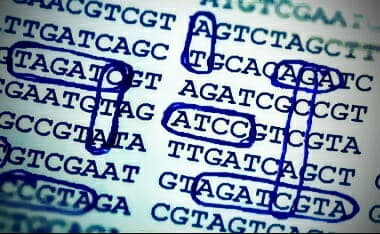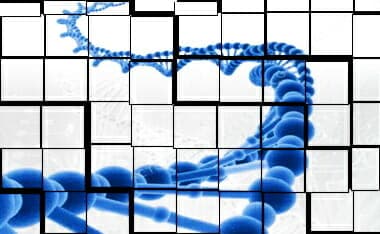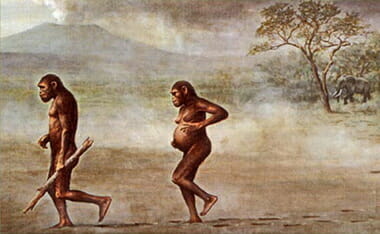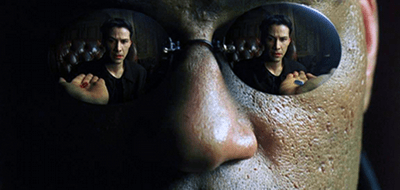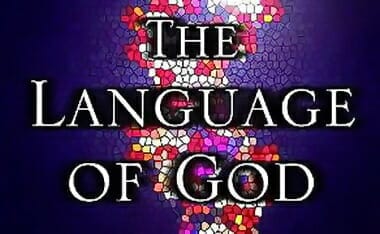- “My whole life has been guided by the principle of Plato’s Socrates: Follow the evidence, wherever it leads.” After chewing on his scientific worldview for more than five decades, Flew concluded, “A super-intelligence is the only good explanation for the origin of life and the complexity of nature.” Previously, in his central work, The Presumption of Atheism (1976), Flew argued that the “onus of proof [of God] must lie upon the theist.” However, at the age of 81, Flew shocked the world when he renounced his atheism because “the argument for Intelligent Design is enormously stronger than it was when I first met it.” Prominent in his conclusion were the discoveries of DNA. | Antony Flew |
What naturalism is is described in the last paragraph. It is also described in a more relational way here, “Love.”
Professor Werner Gitt – Director and professor at the German Federal Institute of Physics and Technology – tells us that:
“The highest information density known to us is that of DNA molecules…. The storage capacity of DNA, the information carriers of living things, is 4.5 x 10 (to the 13th power) times more effective than a megachip!… The sum total of knowledge currently stored in the libraries of the world is estimated at 10(to the 18th power) bits. If this information could be stored in DNA molecules, 1% of the volume of a pinhead would be sufficient for this purpose. If, on the other hand, this information were to be stored with aid of megachips, we would need a pile higher than the distance between the earth and the moon.”
The DNA molecule, of which even the simplest – some would say the most “primitive” – forms of life are composed, is thus 45 million million times more efficient at holding and conveying information than a megachip. This is because the DNA molecule is an incredibly complex three-dimensional information storage system, where the megachip is only two-dimensional. But the DNA molecules ability to store and convey such inconceivably large amounts of information so efficiently does not tell us where the itself comes from. What is the source of that?
Information Theory, of which Professor Gitt is one of the world’s leading exponents, is an important branch of scientific investigation which has shown conclusively and consistently that information cannot and does not arise from any state of non-information, just as life cannot proceed from non-life. Moreover, information has now come to be recognized as the Third Fundamental Quantity of the universe, which hitherto was thought to consist of merely two fundamental quantities, those of matter and energy. The DNA molecule is, of course, matter. Its activities are funded by energy. But the information that it carries is something else entirely. In other words, it is not sufficient to have only matter and energy for DNA to work. What is also required, at least to begin with, is a massive input of information for which matter and energy can give no account, and which neither of them can supply. Again, Professor Gitt:
“According to Norbert Wiener, the founder of cybernetics and information theory, information cannot be of a physical nature, even though it is transmitted by physical means: ‘Information in information, neither matter nor energy. No materialism that fails to take account of this can survive the present day.’”
Because of the increasing disillusionment with the role of chance, a shift took place in the late 60’s and the 70’s to the view that life was somehow the inevitable outcome of nature’s laws at work over vast spans of time. Terms such as “directed chance” and “biochemical predestination” have entered the scientific literature to mean that life was somehow the result of the inherent properties of matter.
But more discomforting still to the materialist, is not just the recent discovery of information to be the Third Fundamental Quantity, but rather the startling realization of its source:
“If a basic code is found in any system, it can be concluded that the system originated from a mental concept, and did not arise by chance…. Meanings always represent mental concepts. They are distinct from matter and energy. They originate from an intelligent source. It is by means of language that information may be stored and transmitted on physical carriers. The information itself is invariant…. The reason for this invariance lies in its non-material nature.”
DNA stores literally coded information || DNA contains codified information || The various codes in the cell
It would seem then that while some materialists have been busy looking in all the wrong places, certain physicists have stumbled upon the Mind of God.
The problem with most of modern science is that the philosophy of reductionism is the ruling paradigm. According to George Williams, a scientist of some stature in the evolutionary community, the crucial object of selection in evolution is inherently non-material:
“Evolutionary biologists have failed to realize that they work with two more or less incommensurable domains: that of information and that of matter…. These two domains can never be brought together in any kind of the sense usually implied by the term ‘reductionism.’ … The gene is a package of information, not an object. The pattern of base pairs in a DNA molecule specifies the gene. But the DNA molecule is the medium, its not the message…. Just the fact that fifteen years ago I started using a computer may have had something to do with my ideas here. The constant process of transferring information from one physical medium to another and then being able to recover the same information in the original medium brings home the separability of information and matter. In biology, when you’re talking about things like genes and genotypes and gene pools, you’re talking about information, not physical objective reality.”
Perhaps evolutionary biologists have avoided noticing that information and matter are fundamentally different things because that insight is fatal to the whole reductionist project in biology. If the message is truly not reducible to the medium, then trying to explain the creation of the information by a materialistic theory is simply a category mistake. One might as well try to explain the origin of a literary work [say, Hamlet] by invoking the chemical laws that govern the combining of ink and paper, and then proposing speculative hypotheses about how those laws (with boost from chance but without intelligence) might have generated meaningful sentences.
Here is some more wonderful information I updated in another post that came from a conversation at Starbucks:
Preliminary Hearing at Starbucks
I had a wonderful conversation with a very nice fellow at Starbucks (I will simply refer to him at times as John D.). The encounter started because of the book I was reading and an unsolicited question about it. It was only AFTER the conversation that I noted why question about the book was asked. The book was “Undeniable: How Biology Confirms Our Intuition That Life Is Designed.” (Watch the author speak about the book HERE.) After the conversation had concluded, I realized what drew John D. into engaging me. During the conversation, as you will see, he intimated that he was a lawyer. Hence, the large title that drew him in is “Undeniable.”
Light conversation took place about the book, mainly because I am just beginning the book and do not know the content well enough yet to discuss it specifically. I did steer the conversation towards DNA just a tad — with Stephen Meyer’s book in mind.
For the reader of this post, keep in mind that while I did not go in-depth into the discussion of DNA that immediately follows, I did reference briefly the aspects of information being separate from the means of transmission [matter]:
Evolutionary biologist George Williams observed: “Evolutionary biologists have failed to realize that they work with two more or less incommensurable domains: that of information and that of matter…. The gene is a package of information, not an object. The pattern of base pairs in a DNA molecule specifies the gene. But the DNA molecule is the medium, it’s not the message…. These two domains will never be brought together in any kind of the sense usually implied by the term ‘reductionism. Information doesn’t have mass or charge or length in millimeters. Likewise, matter doesn’t have bytes…. This dearth of shared descriptors makes matter and information two separate domains of existence, which have to be discussed separately, in their own terms.”[1]
As the information theorist Hubert Yockey observes, the “genetic code is constructed to confront and solve the problems of communication and recording by the same principles found . . . in modern communication and computer codes.” Yockey notes that “the technology of information theory and coding theory has been in place in biology for at least 3.85 billion years,” or from the time that life first originated on earth. What should we make of this fact? How did the information in life first arise?[2]
Codes are not matter and they’re not energy. Codes don’t come from matter, nor do they come from energy. Codes are information, and information is in a category by itself.[3]
A great example is a newspaper.[4] If you read an article on a topic that is information being passed on to you by another intelligence. The modern roadblock for today’s naturalist is the problem of looking at the molecules that make up the ink printed page stores information via the 26 letters of the alphabet as somehow related to the origin of the information being passed on. The problem is that the newspaper is merely the medium, for the information. Like a Compact Disc is for music. The CD is merely the medium to carry the information.
The next question is, how much information can the DNA molecule hold?
a) A pinhead made of DNA: Let us imagine we had enough DNA to fill the volume of a pinhead with a diameter of 2 mm. How many paperbacks (each with 189 pages as in [G19]) could be represented by the information held in that amount of DNA? Answer: about 25 trillion. That would be a pile of these paperback books approximately 920 times the distance from the earth to the moon (384,000 km). In 2011, if we were to equally distribute these paperbacks amongst the approximately 6.93 billion people on Earth, every person would receive about 3,600 copies. b) Drawing a wire: Now let us stretch the material of the 2 mm diameter pinhead into a wire of the same thickness as the DNA molecule (2 x 10-6 mm). How long would this wire be? Unbelievably, it would stretch 33 times around the equator, which has a circumference of 24,860 miles (40,000 km). c) One thousandth of a gram of DNA: If we were to take a milligram (1 mg = 10-3 g) of a (double helix) strand of DNA material, it would almost stretch from the earth to the moon![5] (Click to enlarge) Dr. George Church, a pioneering molecular geneticist at Harvard/MIT, informed us in a Sciencexpress article in August of 2012, that the digital-information storage capacity of DNA is “very dense.” How dense? One gram of DNA can store 455 exabytes of information. For those readers like myself whose eyes glaze over as soon as computer nerds start talking about bytes and RAM’s I will put it in simple layman’s terms. One gram of DNA – the weight of two Tylenol – can store the same amount of digitally encoded information as a hundred billion DVD’s. Yes, you read correctly, I said a hundred billion DVD’s. Every single piece of information that exists on the Earth today; from every single library, from every single data base, from every single computer, could be stored in one beaker of DNA. This is the same DNA/Genetic Information/Self-Replication System that exists in humans and in bacteria (which are the simplest living organisms that exist today and have ever been known to exist). In short, our DNA-based genetic code, the universal system for all life on our planet, is the most efficient and sophisticated digital information storage, retrieval, and translation system known to man.[6] I will repeat a line from the above graphic description: Let me give you another example of the same sort of reasoning. Imagine that you have just finished reading a fabulous novel. Wanting to read another book like it, you exclaim to a friend, “Wow! That was quite a book. I wonder where I can get a bottle of that ink?” Of course not! You wouldn’t give the ink and paper credit for writing the book. You’d praise the author, and look for another book by the same writer. By some twist of logic, though, many who read the fabulous DNA script want to give credit to the “ink (DNA base code) and paper (proteins)” for composing the code. In a novel, the ink and paper are merely the means the author uses to express his or her thoughts. In the genetic code, the DNA bases and proteins are merely the means God uses to express His thoughts.[7] Human DNA is like a computer program but far, far more advanced than any software ever created.[8] Information is information, neither matter nor energy. No materialism that fails to take account of this can survive the present day. – Norbert Weiner, MIT Mathematician and Father of Cybernetics[9] [1] This is a fuller quote adapted from two sources: Donald E. Johnson, Probability’s Nature and Nature’s Probability : A Call to Scientific Integrity (Charleston, SC: Booksurge Publishing, 2009), 44; Stephen C. Meyer, Signature in the Cell: DNA and the Evidence for Intelligent Design (New York, NY: Harper One, 2009), 17. [2] Meyer, ibid. [3] Perry Marshall, Evolution 2.0: Breaking the Deadlock Between Darwin and Design (Dallas, TX: Benbella Books, 2016), 187. [4] The graphic to the right of the footnote is from, Werner Gitt, In the Beginning Was Information (Bielefeld, Germany: Christliche Literatur-Verbreitung, 1997), 86. [5] Werner Gitt, Without Excuse (Atlanta, GA: Creation Book Publishers, 2011), 288 (graph from p. 286). [6] Moshe Averick, Atheistic Science is Rapidly Sinking in the Quicksand, algemeiner. [7] Gary Parker, 1.3 The Origin of Life: DNA and Protein, AiG. [8] Bill Gates, The Road Ahead (New York, NY: Penguin Group, 1995), 188. [9] Stan Lennard, So Easy a Caveman Could Do It?, RtB.
Here is a great presentation[s] and a QandA by Stephen Meyer discussing his Signature In The Cell:
ONE MUST INCLUDE THESE OTHER POSTS AS WELL!!!
